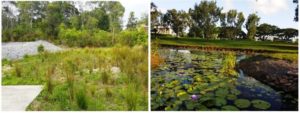In Queensland, Australia, two Griffith University doctoral researchers have been awarded an artificial intelligence “AI for Earth” Azure Award from Microsoft to access data to develop a below and above-ground carbon interchange model of green stormwater infrastructure in our cities.
Emad Kavehei is in his final year at Griffith’s Cities Research Institute (CRI), supervised by Dr. Graham Jenkins, Dr. Fernanda Adame and Professor Charles Lemckert. Abdul Karim is in his first year at Griffith’s Institute for Integrated and Intelligent Systems, supervised by Professor Abdul Sattar.
“Traditionally, we monitor a few influencing factors of soil carbon accumulation while we know that there are more factors involved,” Kavehei said.
“Microsoft is supporting this project which builds on my PhD studies, to create and deploy an open source model to predict the below-ground carbon content based on above ground image data,” he added.
“We believe integrating different levels of relevant data with the state-of-the-art AI methods would better enable us to predict the urban carbon budget,” Karim said.
Terrestrial carbon storage in soil accounts for more than 65% of global carbon which makes it a recognized strategy for climate change mitigation.
However, there is a little understanding of the carbon storage in urban areas. Vegetated stormwater infrastructure such as bioretention basins are normal features of an urban landscape.
These aquatic and terrestrial ecosystems have great potential to capture and sequester carbon within below-ground media.
By the end of 2019, Kavehei and Karim will access Microsoft’s data to create computer vision and Artificial Intelligence-based solutions for analysing and predicting the carbon sequestration potential of such bioretention basins.
They intend for their work, as part of CRI’s Digital Earth and Green Infrastructure Group, to have immediate application in predicting and quantifying the benefit of similar green infrastructure installations within sandy loam soils, for capturing atmospheric carbon.
Griffith University is one of only two Australian universities to be awarded the Azure Award in this round of grants.
Featured photo via Adobe Stock.
The original version of this article by Carley Rosengreen originally appeared on the website of Griffin University.


